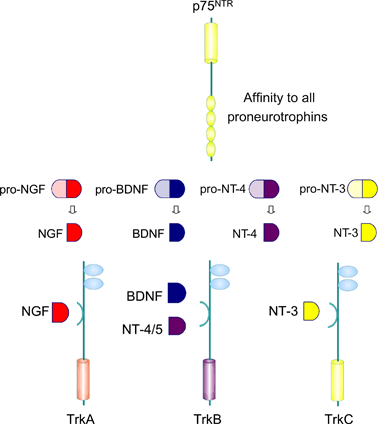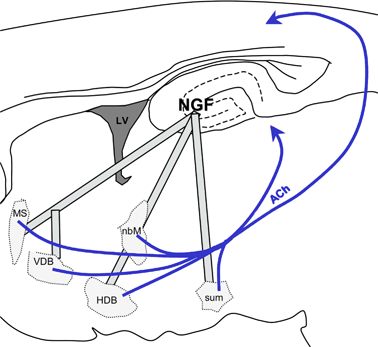Neurotrophic factors in Alzheimer's disease: role of axonal transport
- PMID: 18184369
- PMCID: PMC2228393
- DOI: 10.1111/j.1601-183X.2007.00378.x
Neurotrophic factors in Alzheimer's disease: role of axonal transport
Abstract
Neurotrophic factors (NTF) are small, versatile proteins that maintain survival and function to specific neuronal populations. In general, the axonal transport of NTF is important as not all of them are synthesized at the site of its action. Nerve growth factor (NGF), for instance, is produced in the neocortex and the hippocampus and then retrogradely transported to the cholinergic neurons of the basal forebrain. Neurodegenerative dementias like Alzheimer's disease (AD) are linked to deficits in axonal transport. Furthermore, they are also associated with imbalanced distribution and dysregulation of NTF. In particular, brain-derived neurotrophic factor (BDNF) plays a crucial role in cognition, learning and memory formation by modulating synaptic plasticity and is, therefore, a critical molecule in dementia and neurodegenerative diseases. Here, we review the changes of NTF expression and distribution (NGF, BDNF, neurotrophin-3, neurotrophin-4/5 and fibroblast growth factor-2) and their receptors [tropomyosin-related kinase (Trk)A, TrkB, TrkC and p75(NTR)] in AD and AD models. In addition, we focus on the interaction with neuropathological hallmarks Tau/neurofibrillary tangle and amyloid-beta (Abeta)/amyloid plaque pathology and their influence on axonal transport processes in order to unify AD-specific cholinergic degeneration and Tau and Abeta misfolding through NTF pathophysiology.
Figures


Similar articles
-
Pretangle pathology within cholinergic nucleus basalis neurons coincides with neurotrophic and neurotransmitter receptor gene dysregulation during the progression of Alzheimer's disease.Neurobiol Dis. 2018 Sep;117:125-136. doi: 10.1016/j.nbd.2018.05.021. Epub 2018 May 31. Neurobiol Dis. 2018. PMID: 29859871 Free PMC article.
-
Cerebrolysin modulates pronerve growth factor/nerve growth factor ratio and ameliorates the cholinergic deficit in a transgenic model of Alzheimer's disease.J Neurosci Res. 2013 Feb;91(2):167-77. doi: 10.1002/jnr.23142. Epub 2012 Nov 14. J Neurosci Res. 2013. PMID: 23152192
-
Investigation of the Molecular Role of Brain-Derived Neurotrophic Factor in Alzheimer's Disease.J Mol Neurosci. 2022 Feb;72(2):173-186. doi: 10.1007/s12031-021-01824-8. Epub 2021 Aug 23. J Mol Neurosci. 2022. PMID: 34424488 Review.
-
Retrograde axonal transport of BDNF and proNGF diminishes with age in basal forebrain cholinergic neurons.Neurobiol Aging. 2019 Dec;84:131-140. doi: 10.1016/j.neurobiolaging.2019.07.018. Epub 2019 Aug 10. Neurobiol Aging. 2019. PMID: 31574357
-
The cholinergic system, nerve growth factor and the cytoskeleton.Behav Brain Res. 2011 Aug 10;221(2):515-26. doi: 10.1016/j.bbr.2010.02.024. Epub 2010 Feb 16. Behav Brain Res. 2011. PMID: 20170684 Review.
Cited by
-
Trophic factor-induced activity 'signature' regulates the functional expression of postsynaptic excitatory acetylcholine receptors required for synaptogenesis.Sci Rep. 2015 Apr 1;5:9523. doi: 10.1038/srep09523. Sci Rep. 2015. PMID: 25827640 Free PMC article.
-
Recent advances in our understanding of neurodegeneration.J Neural Transm (Vienna). 2009 Sep;116(9):1111-62. doi: 10.1007/s00702-009-0240-y. Epub 2009 Jun 5. J Neural Transm (Vienna). 2009. PMID: 19707851 Review.
-
The Protective Effects of PSM-04 Against Beta Amyloid-Induced Neurotoxicity in Primary Cortical Neurons and an Animal Model of Alzheimer's Disease.Front Pharmacol. 2019 Jan 24;10:2. doi: 10.3389/fphar.2019.00002. eCollection 2019. Front Pharmacol. 2019. PMID: 30733674 Free PMC article.
-
Neural stem cell-derived small extracellular vesicles attenuate apoptosis and neuroinflammation after traumatic spinal cord injury by activating autophagy.Cell Death Dis. 2019 Apr 18;10(5):340. doi: 10.1038/s41419-019-1571-8. Cell Death Dis. 2019. PMID: 31000697 Free PMC article.
-
Amyloid-Beta Induced Changes in Vesicular Transport of BDNF in Hippocampal Neurons.Neural Plast. 2016;2016:4145708. doi: 10.1155/2016/4145708. Epub 2016 Jan 10. Neural Plast. 2016. PMID: 26881108 Free PMC article.
References
-
- Adalbert R, Gilley J, Coleman MP. Abeta, tau and ApoE4 in Alzheimer’s disease: the axonal connection. Trends Mol Med. 2007;13:135–142. - PubMed
-
- Akatsu H, Yamagata HD, Kawamata J, Kamino K, Takeda M, Yamamoto T, Miki T, Tooyama I, Shimohama S, Kosaka K. Variations in the BDNF gene in autopsy-confirmed Alzheimer’s disease and dementia with Lewy bodies in Japan. Dement Geriatr Cogn Disord. 2006;22:216–222. - PubMed
-
- Allen SJ, Wilcock GK, Dawbarn D. Profound and selective loss of catalytic TrkB immunoreactivity in Alzheimer’s disease. Biochem Biophys Res Commun. 1999;264:648–651. - PubMed
Publication types
MeSH terms
Substances
LinkOut - more resources
Full Text Sources
Medical
Research Materials

